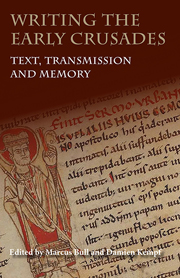Book contents
- Frontmatter
- Contents
- Acknowledgements
- List of Contributors
- List of Abbreviations
- Introduction
- Baldric of Bourgueil and the Familia Christi
- Guibert of Nogent, Albert of Aachen and Fulcher of Chartres: Three Crusade Chronicles Intersect
- Understanding the Greek Sources for the First Crusade
- The Monte Cassino Tradition of the First Crusade: From the Chronica Monasterii Casinensis to the Hystoria de via et recuperatione Antiochiae atque Ierusolymarum
- Nova Peregrinatio: The First Crusade as a Pilgrimage in Contemporary Latin Narratives
- What Really Happened to Eurvin de Créel's Donkey? Anecdotes in Sources for the First Crusade
- Porta Clausa: Trial and Triumph at the Gates of Jerusalem
- The Historia Iherosolimitana of Robert the Monk and the Coronation of Louis VI
- Towards a Textual Archaeology of the First Crusade
- Robert the Monk and his Source(s)
- Rewriting the History Books: The First Crusade and the Past
- The Ideal of Knighthood in English and French Writing, 1100–1230: Crusade, Piety, Chivalry and Patriotism
- Index
Understanding the Greek Sources for the First Crusade
Published online by Cambridge University Press: 05 May 2014
- Frontmatter
- Contents
- Acknowledgements
- List of Contributors
- List of Abbreviations
- Introduction
- Baldric of Bourgueil and the Familia Christi
- Guibert of Nogent, Albert of Aachen and Fulcher of Chartres: Three Crusade Chronicles Intersect
- Understanding the Greek Sources for the First Crusade
- The Monte Cassino Tradition of the First Crusade: From the Chronica Monasterii Casinensis to the Hystoria de via et recuperatione Antiochiae atque Ierusolymarum
- Nova Peregrinatio: The First Crusade as a Pilgrimage in Contemporary Latin Narratives
- What Really Happened to Eurvin de Créel's Donkey? Anecdotes in Sources for the First Crusade
- Porta Clausa: Trial and Triumph at the Gates of Jerusalem
- The Historia Iherosolimitana of Robert the Monk and the Coronation of Louis VI
- Towards a Textual Archaeology of the First Crusade
- Robert the Monk and his Source(s)
- Rewriting the History Books: The First Crusade and the Past
- The Ideal of Knighthood in English and French Writing, 1100–1230: Crusade, Piety, Chivalry and Patriotism
- Index
Summary
In April 1081, a young general named Alexios Komnenos was crowned Emperor of the Romans in the great imperial city of Constantinople. He was the fifth man to rule the Byzantine empire in less than fifteen years. He took power from Nikephoros III Botaneiates, himself a usurper, who had been incompetent and ineffective in his three years on the throne, more keen on choosing fabric for his clothes than in dealing with affairs of state – a barb carefully chosen by an author writing later to contrast with Alexios's commitment, resolve and lack of pretence. The new emperor could barely have chosen a less auspicious moment to take responsibility for the empire. Relations with the papacy were at an all-time low, to the point that no sooner had Alexios been crowned than he was excommunicated by Pope Gregory VII – just as had happened to his predecessor. He was also facing a major attack on the western coast of Epirus, led by Robert Guiscard, one of the great figures of the early medieval period, who had established Norman control over southern Italy and Sicily, and was now seeking to extend his authority on the eastern side of the Ionian and Adriatic Seas.
Byzantium was in trouble elsewhere too. Its Danube frontier seemed to be porous, allowing steppe nomad raiders to cross over and plunder the Balkans with impunity.
- Type
- Chapter
- Information
- Writing the Early CrusadesText, Transmission and Memory, pp. 38 - 52Publisher: Boydell & BrewerPrint publication year: 2014

